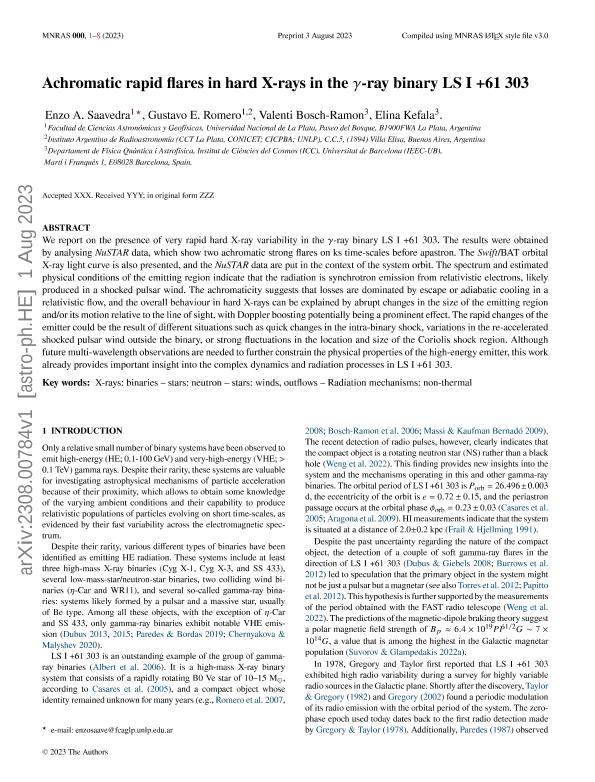Artículo
Achromatic rapid flares in hard X-rays in the γ-ray binary LS I + 61 303
Fecha de publicación:
10/2023
Editorial:
Wiley Blackwell Publishing, Inc
Revista:
Monthly Notices of the Royal Astronomical Society
ISSN:
0035-8711
Idioma:
Inglés
Tipo de recurso:
Artículo publicado
Clasificación temática:
Resumen
We report on the presence of very rapid hard X-ray variability in the γ-ray binary LS I + 61 303. The results were obtained by analysing Nuclear Spectroscopic Telescope Array (NuSTAR) data, which show two achromatic strong flares on ks time-scales before apastron. The Swift/Burst Alert Telescope orbital X-ray light curve is also presented, and the NuSTAR data are put in the context of the system orbit. The spectrum and estimated physical conditions of the emitting region indicate that the radiation is synchrotron emission from relativistic electrons, likely produced in a shocked pulsar wind. The achromaticity suggests that losses are dominated by escape or adiabatic cooling in a relativistic flow, and the overall behaviour in hard X-rays can be explained by abrupt changes in the size of the emitting region and/or its motion relative to the line of sight, with Doppler boosting potentially being a prominent effect. The rapid changes of the emitter could be the result of different situations such as quick changes in the intra-binary shock, variations in the re-accelerated shocked pulsar wind outside the binary, or strong fluctuations in the location and size of the Coriolis shock region. Although future multiwavelength observations are needed to further constrain the physical properties of the high-energy emitter, this work already provides important insight into the complex dynamics and radiation processes in LS I + 61 303.
Archivos asociados
Licencia
Identificadores
Colecciones
Articulos(IAR)
Articulos de INST.ARG.DE RADIOASTRONOMIA (I)
Articulos de INST.ARG.DE RADIOASTRONOMIA (I)
Citación
Saavedra, Enzo Agustin; Romero, Gustavo Esteban; Bosch Ramon, Valentí; Kefala, Elina; Achromatic rapid flares in hard X-rays in the γ-ray binary LS I + 61 303; Wiley Blackwell Publishing, Inc; Monthly Notices of the Royal Astronomical Society; 525; 2; 10-2023; 1848-1855
Compartir
Altmétricas




